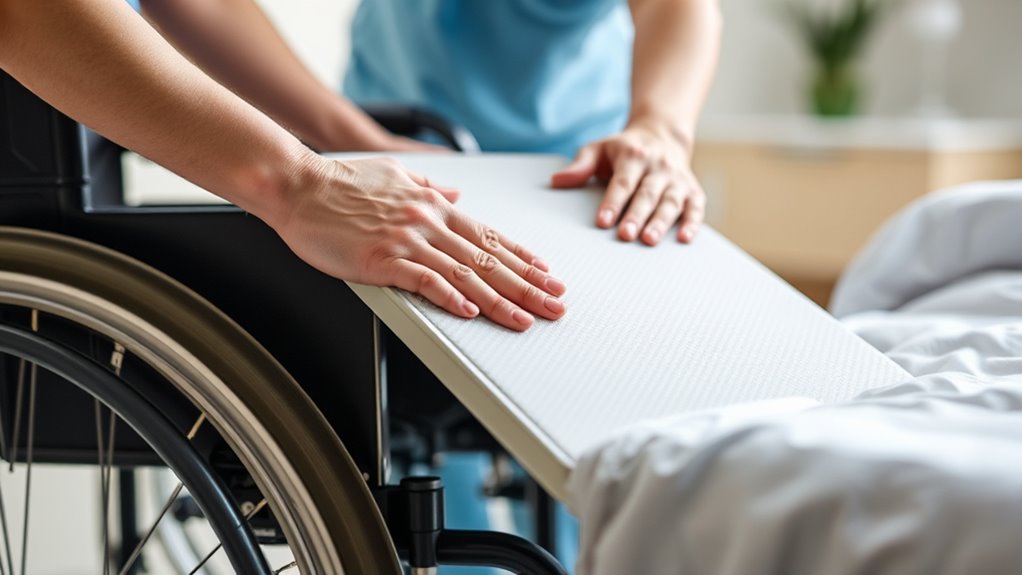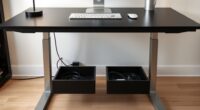To use transfer boards and slide sheets safely, guarantee proper positioning before starting and support the patient’s head, neck, and limbs to prevent discomfort. Inspect equipment regularly for damage, keep it clean, and store it properly. Secure devices during transfer and verify they’re in good condition. Communicate clearly with the patient, explaining each step to promote cooperation. Maintain proper body mechanics to protect yourself. Keep these tips in mind to perform safe transfers—more details await if you continue.
Key Takeaways
- Inspect and maintain transfer boards and slide sheets regularly to ensure they are free of tears and in good working condition.
- Properly position and stabilize the patient to prevent slips and ensure a secure transfer foundation.
- Verify correct device placement and secure equipment before initiating transfer to avoid shifting or accidents.
- Communicate clearly with the patient throughout the transfer to promote cooperation and reduce anxiety.
- Use proper body mechanics, bending at hips and knees, to minimize injury risk during movement.

Transfer boards and slide sheets are essential tools that help you move patients safely and comfortably. Using them correctly is vital to prevent injuries to both the patient and yourself. One of the most important aspects of using these devices effectively is ensuring proper positioning. Before starting any transfer, you need to position the patient correctly, which involves adjusting their body to align with the transfer device. This means supporting the head, neck, and limbs to prevent strain or discomfort. Proper positioning also includes making sure the patient is centered and stable on the transfer surface, reducing the risk of falls or slips during movement. When you position the patient properly, you create a secure foundation for the transfer, minimizing the chance of injury or discomfort.
Equally important is equipment maintenance. Regularly inspecting your transfer boards and slide sheets ensures they are in good condition and safe to use. Check for tears, frayed edges, or signs of wear that could compromise their strength or safety. Damaged equipment should never be used, as it could break during transfer, leading to potential injuries. Cleanliness is another key factor—clean and disinfect the devices after each use to prevent infections. Proper storage is also essential; keep your transfer tools in a designated, dry area where they won’t get damaged or contaminated. Well-maintained equipment not only enhances safety but also prolongs its usability, saving you money and ensuring reliable performance every time. Additionally, understanding the contrast ratio of your transfer devices can help ensure optimal visibility and safety during low-light conditions.
When preparing for a transfer, always verify the transfer board or slide sheet is properly positioned under or over the patient. Secure the device so it doesn’t shift during the move, which could cause discomfort or imbalance. Communicate clearly with the patient, explaining each step to keep them calm and cooperative. As you perform the transfer, maintain proper body mechanics—bend at your hips and knees, keep your back straight, and use your leg muscles to lift or slide the patient. This approach minimizes your risk of injury while facilitating a smooth transfer.
Frequently Asked Questions
How Do I Choose the Right Transfer Board or Slide Sheet?
To choose the right transfer board or slide sheet, consider its ergonomic design for comfortable handling and ease of use. Look for materials with high durability to withstand frequent use without damage. Think about the weight capacity and surface texture, ensuring they match the patient’s needs. Additionally, select a size that fits comfortably between surfaces, making transfers safer and more efficient for both you and the patient.
What Are Common Mistakes to Avoid During Transfers?
To avoid common mistakes during transfers, focus on proper techniques to prevent skin injuries, like confirming the transfer board or slide sheet is secure before moving. Always communicate clearly with the person you’re assisting, explaining each step to prevent confusion and ensure safety. Avoid rushing or applying excessive force, and double-check that the equipment is correctly positioned. Good communication and gentle handling are key to safe, injury-free transfers.
Can Transfer Boards Be Used on All Surface Types?
Transfer boards can’t just be used on any surface like magic. Surface compatibility is essential for transfer safety; using them on uneven, sticky, or rough surfaces can be disastrous. You must assess each surface carefully before use, ensuring it’s stable and smooth enough. Otherwise, you risk slips, falls, and injuries. Always check the surface type first—your safety depends on it, and so does the person’s you’re helping.
How Often Should Transfer Aids Be Replaced or Inspected?
You should inspect your transfer aids regularly, ideally before each use, following a maintenance checklist. Replace them if you notice any signs of damage or wear, such as cracks or tears. Typically, you should replace transfer aids annually or as recommended by the manufacturer. Frequent inspections ensure safety and proper function, preventing accidents or injuries. Always adhere to your organization’s guidelines for inspection frequency and maintenance to keep your equipment in excellent condition.
Are There Specific Training Requirements for Safe Use?
Did you know that proper technique can reduce transfer-related injuries by up to 80%? To guarantee safety, staff must undergo specific training on the safe use of transfer boards and slide sheets. This training covers proper technique, handling, and positioning. Regular staff training not only enhances safety but also boosts confidence. Make sure your team stays updated with current guidelines to prevent accidents and provide the best care possible.
Conclusion
Using transfer boards and slide sheets safely is like steering a ship through calm waters—you guide with care, ensuring stability for both you and your patient. When you follow proper techniques, you create a smooth, seamless transfer that minimizes risks and maximizes comfort. Remember, your attentiveness is the anchor that keeps everyone secure. Stay vigilant, respect the tools, and navigate each transfer with confidence, turning a potentially intimidating task into a safe and confident voyage.









